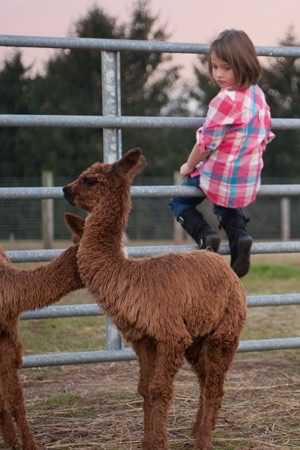about alpacas
Welcome to the world of alpacas! The alpaca belongs to the Camelid family, which also includes the Llama, Guanaco, and the Vicuna. Alpacas are gentle, inquisitive, and safe with children. Their diet consists of hay and grazing pastures and they do not challenge fences.

Adult females weigh approximately 150 pounds and males approximately 185 pounds. Alpacas have a gestation length of between 335 - 345 days and they deliver a cria (baby) that weighs 16 - 18 pounds! There are more than 22 naturally occurring colors of alpacas and their fibers can produce a multitude of luxurious products!
There are two types of alpacas: the suri and the huacaya. The only difference is the varying traits of the fiber. Both yield soft, fine, warm, and hypoallergenic fiber. However, the suris' fiber falls in long twisted locks and possesses a beautiful luster, whereas the huacaya is wooly and crimped. Suri Alpacas represent just 3% of the worldwide alpaca population.
Alpacas were first imported into the United States in 1984 from South America. The Alpaca Registry was founded in 1988 and the alpaca's registration validates the alpacas' pedigree and tracks the bloodline. However, the US borders were closed in 1998 to any newly imported animals in an effort to improve the breed in this country. United States' alpacas fall into three categories: show/breeding quality, fleece quality animals, and companion animals. Bred show quality females can be valued between $12,000 - $40,000.

